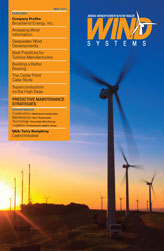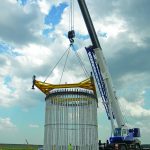The FMCSA (Federal Motor Carrier Safety Administration) has implemented a new safety measurement program, referred to as CSA2010, intended to improve road safety and reduce highway accidents. The new measurement system is very complex and will affect the entire trucking industry, and it could impact industries that require heavy haul transport. The potential effects on the wind industry include a reduction in capacity and higher compliance costs.
The new rules create a fundamental change on how carrier safety is measured. Prior to CSA2010 carriers received a general pass/fail/conditional safety rating. The new Safety Management System (SMS) will use existing data sources to expand the rating criteria to six carrier safety fitness categories. In addition, the new measurements will drill down to the driver level detail to identify high-risk behavior. The intention of the new measures is for carriers to take more accountability over the safety of their drivers and their owner/operators.
CSA2010 will directly impact carriers. The more detailed ratings will more likely identify carriers with weak audit and compliance safety programs. To ensure compliance with the new rules and protect their safety rating, carriers will need maintain robust safety programs including investing in driver training, developing and documenting safe processes and procedures, and conducting in-house audits so that potential problems areas are addressed early. Carriers with these systems already in place may be minimally impacted by the new rules. Carriers with weak programs will experience increased compliance costs. Smaller or weaker carriers may be unable to meet all the requirements.
There is also legitimate concern that insurers will use the rating system to assess insurance qualification and rates. Since moving wind cargo is high risk by its nature, some carriers may choose, or be forced, to exit the wind business.
The new regulations will have an indirect effect on the pool of drivers. It is expected that carriers are going to be highly sensitive to the safety records of their drivers and will weed out the poor performers and refuse to hire drivers with bad safety records. Some estimate that up to 10 percent of the driver pool may unemployable. Driver safety records will remain part of the carrier’s safety rating for two years, but because the records are time weighted the effect is more short term. So as the CSA2010 ramps up and the economy stays soft, it is highly probable that a shortage of drivers will occur. Carriers will be looking at a driver’s past performance to see what risks they may taking when hiring the driver, and each company will set its own standards.
Fortunately, the heavy haul industry tends to have the most experienced and safest drivers, so the immediate impact of the new rules may be minimal. A greater threat to the wind industry is the ongoing depletion of qualified drivers due to retirements, the “boom/bust” nature of the industry, and occupational frustrations including many nights away from home. The new rules add a further risk factor for driver employment prospects and an additional barrier to the carrier’s ability to attract new driver entrants. It takes many years to fully qualify as a heavy haul drivers and prospective new entrants may be unwilling to make the commitment due to high risk. The economic slowdown in the wind industry has led to driver exits. When the wind industry finally rebounds from its current levels, there will be fewer available drivers to handle the cargo.
The strongest companies will be motivated to hire and compensate the drivers with the best safety ratings. The competition for the best drivers will increase carrier costs, which eventually will be passed on to the shipper as higher rates.
The new SMS was tested in nine states in 2008 through 2010. Since April 2010, a preview of carrier data was available via the SMS system. In December 2010 the system was officially in effect, with full implementation expected by the first half of 2011.
CSA2010 is a big improvement toward improving overall road safety, but it still has its drawbacks. For one, it only addresses the commercial side of road behaviors. Secondly, the new requirements will add more cost in an industry already suffering from low margins. As demand for wind equipment increases along with the cost of operations, shippers are sure to see higher shipping rates. Finally, even though drivers are not directly affected by the rules, they will feel the pressure from their employers. A limited number of road side warning or citations may discourage drivers from entering the field and put more pressure on the availability of drivers.




































